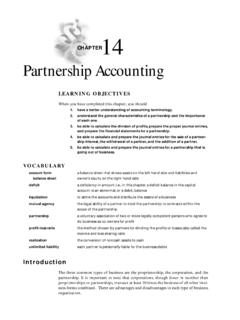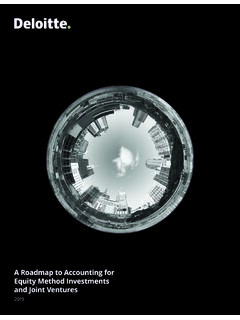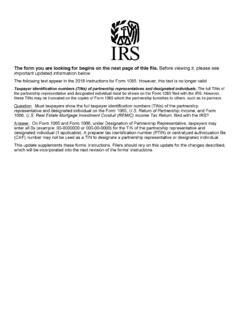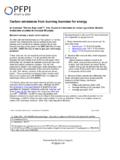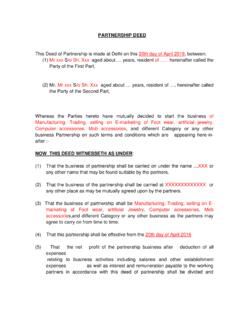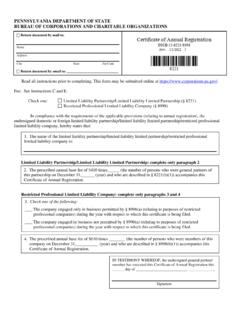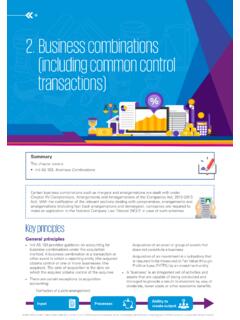Transcription of Module 3 - sepassets.blob.core.windows.net
1 Module 3 Scope 3 Emissions Accountingin partnership with and Module 3 Scope 3 Emissions Accounting2 For informational purposes only. Not legal advice or to Module 3: Scope 3 Emissions AccountingBefore we start our training, please find the keys to our interactive PDF. Previous pageExpand windowKey conceptsFurther resourcesHomeMinimize windowSteps needed to prepare for accounting emissionsNext pageClick here for more informationCheck out this videoModule 3 Scope 3 Emissions Accounting3 For informational purposes only. Not legal advice or to Module 3: Scope 3 Emissions AccountingWe estimate this Module will take 35 minutes for a first read-through (excluding the Appendix). It can then be used as a step-by-step guide as you complete your Scope 3 emissions Module will take you through the step-by-step process for accounting for your company s Scope 3 GHG emissions.
2 As a reminder, Scope 3 emissions are all other emissions that aren t included in Scope 1 or 2. These emissions are indirect because they fall outside of a company s direct control. All companies have value chains; therefore, they will have Scope 3 emissions. Module 3 Scope 3 Emissions Accounting4 For informational purposes only. Not legal advice or to know about Scope 3 Emissions accounting Before you get started, it s important to know that Scope 3 emissions are much more complicated to account for than Scope 1 & 2 emissions. The purpose of accounting for these emissions isn t to get the perfect inventory. For most companies, Scope 3 emissions accounting will be a journey during which their emissions inventories get more comprehensive and granular over time. For this reason, this training focuses on providing a high-level introduction to evaluating emissions across your company s value chain.
3 This will help you identify emissions hotspots so that you can figure out how to start managing the associated risks. We provide the most basic calculation approaches in the core portion of the Module . However, if you feel ready to explore more granular calculation approaches, we ve included this information in an Appendix to this Module . Module 3 Scope 3 Emissions Accounting5 For informational purposes only. Not legal advice or to know about Scope 3 Emissions accounting It s also helpful to know that Scope 3 emissions are typically much larger than Scope 1 & 2 emissions. This is because they are the emissions across your entire supply chain. In fact, upstream supply chain emissions are on average times higher than operational (Scope 1 & 2) emissions. The graph to the right shows a sector-specific perspective of this same metric.
4 The retail, apparel and services sectors have some of the highest ratios of Scope 3 supply chain emissions to Scope 1 & 2 emissions. Food, beverage & Biotech, health care & Transportation Power Fossil FuelsUpstream emissions: Scope 3 emissions are on average times higher than operational emissionsAverage of final ratio (Scope 3 [supply chain emissions]: Scope 1 + 2 [operational emissions and direct emissions])Source: CDP Global Supply Chain Report 2020 Module 3 Scope 3 Emissions Accounting6 For informational purposes only. Not legal advice or objectivesIn this Module , you will learn: The importance of accounting for Scope 3 emissions How Scope 3 emissions are categorized, and how to identify which Scope 3 categories are relevant to your company How to start measuring and reporting on your Scope 3 footprint What other estimation methods exist to refine your Scope 3 footprint1.
5 Assess Greenhouse Gas Emissions3. Shift to Low- or No-Emission Energy2. Optimize Energy UseGreenhouse Gas Emissions AccountingCapacity Building ObjectiveRenewable Energy ProcurementEnergy EfficiencyThis training is the first part of a capacity building series on reducing energy-related greenhouse gas emissionsModule 3 Scope 3 Emissions Accounting7 For informational purposes only. Not legal advice or you complete this Module , the following Module remains: Module 4 Emissions Reductions 101 Module 3 Scope 3 Emissions Accounting8 For informational purposes only. Not legal advice or to know before you get startedModule 3 Scope 3 Emissions Accounting9 For informational purposes only. Not legal advice or 1: Scope 3 foundationsSection 2: Estimating Scope 3 emissionsLet s get started with a high level overviewThis Module is divided into two sections that will help you understand the fundamental concepts for Scope 3 emissions accounting : Module 3 Scope 3 Emissions Accounting10 For informational purposes only.
6 Not legal advice or 1: Scope 3 foundationsModule 3 Scope 3 Emissions Accounting11 For informational purposes only. Not legal advice or UpstreamRaw materials extractionWasteManufacturing TransportationWholesaleOperationsProcess ing End-of-life managementWholesale InvestmentsDistribution & retail TransportationThe purpose of Scope 3 accounting it to understand and measure your company s value chainEstimating Scope 3 emissions better evaluates the impact of your activities on your value chain and helps reduce the carbon and environmental footprint of your value chain. This can help drive a ripple effect with other companies both upstream and downstream in your value chain. Module 3 Scope 3 Emissions Accounting12 For informational purposes only. Not legal advice or importance of understanding your company s value chainAt its core, Scope 3 emissions accounting is really about understanding your company s value chain and its GHG emissions.
7 Therefore, before you dive into the Module content, we suggest that you start by drawing out your company s value chain (both upstream and downstream) at a high level. Questions that might help you do this include: 9 What products or services does your company sell? 9 How does your company get inputs to create the products and services it sells? 9 How do your company s products or services get to customers? 9 How do customers use your company s products?DownstreamCompanyUpstreamModule 3 Scope 3 Emissions Accounting13 For informational purposes only. Not legal advice or the mapping you created from the previous page and think about how it maps to each of these 15 GHG Protocol Scope 3 categories:Purchased goods and servicesCapital goodsFuel and energy related activitiesUpstream transportation and distributionWaste generated in operationsBusiness travelEmployee commuting Upstream leased assetsDownstream Downstream transportation and distributionProcessing of sold productsUse of sold products End-of-life treatment of sold productsDownstream leased assets FranchisesInvestmentsIndirect emissions from purchased or acquired goods and servicesIndirect emissions related to sold goods and services UpstreamGiven the difficulty of data collection, corporate Scope 3 inventories typically focus on a limited number of categories that are most relevant for a specific company s operating model.
8 We will explain this in more detail in Module 3 Scope 3 Emissions Accounting14 For informational purposes only. Not legal advice or Scope 3 emissions are beyond the control of my company, why should I account for them?There are several benefits of accounting for Scope 3 GHG emissions. These include:1. Managing risks in your company s value chain2. Setting credible and comprehensive decarbonization goals across all scopes of emissions3. Helping catalyze decarbonization across your value chainModule 3 Scope 3 Emissions Accounting15 For informational purposes only. Not legal advice or 1 Managing risks in your company s value chainMeasuring your Scope 3 emissions can help you better identify and manage value chain physical and transition risks associated with climate change can impact the operational resilience of companies.
9 Conducting a Scope 3 assessment will give you a better sense of where your company is exposed to these risks. Identifying high GHG emissions hotspots allows companies to engage with key suppliers, manage risks more effectively and work to reduce their emissions. Natural disasters Commodity price hikes/availability Supply chain failure Workforce instability Trade barriers Consumer boycott Distribution failure Waste disposal disruptionsValue Chain StagesExamples of DisruptionsDownstreamCompanyUpstreamModu le 3 Scope 3 Emissions Accounting16 For informational purposes only. Not legal advice or 2 Setting credible and comprehensive decarbonization goals across all scopes of emissionsAn understanding of your company s Scope 3 emissions is necessary for setting a credible and comprehensive decarbonization : Science Based Targets Initiative (SBTi) Module 3 Scope 3 Emissions Accounting17 For informational purposes only.
10 Not legal advice or 3 Catalyzing decarbonization across your value chainFrom suppliers and distributors to customers and employeesUnderstanding your own company s Scope 3 emissions unlocks the opportunity to engage with stakeholders across your value chain to collectively drive decarbonization. Module 3 Scope 3 Emissions Accounting18 For informational purposes only. Not legal advice or 2: Estimating Scope 3 emissionsModule 3 Scope 3 Emissions Accounting19 For informational purposes only. Not legal advice or five-step approach to getting started on measuring and reporting on your Scope 3 footprint:1. Screen Scope 3 CategoriesIdentify which Scope 3 categories apply to your Select the Estimation Method(s)For each category selected in Step 1, choose the estimation method based on data Collect Activity DataFor each category selected, collect the activity data based on the estimation method selected in Step Estimate Scope 3 EmissionsSelect a free online tool or database to estimate Scope 3 Consolidate Scope 3 FootprintSum the estimates of the selected Scope 3 categories and report on your Scope 3 : The purpose of this Module is to learn how to do a Scope 3 estimation for GHG disclosure purposes, not to develop a formal Scope 3 inventory.


